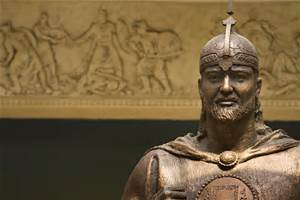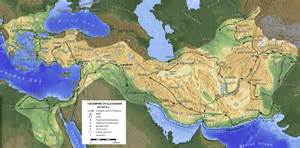
Did you know that Latin was not always used as the liturgical language?
The first liturgical language used in Rome was Greek! Even this is a consequence of Romanitas.
One of the characteristic of the Romans was to absorb other cultures they had conquered  and the most influential of these was that of the Greeks. Through the conquests of Alexander the Great, Greek culture which includes its language had been spread throughout the Mediterranean world, even reaching as far as India. During the time of Our Lord Jesus Christ, Greek was being used throughout the Roman Empire as the universal language, even in the province of Judea. Not only does strong evidence exist that Our Lord Himself spoke Greek, in addition to Aramaic and Hebrew, but His Apostles also.
and the most influential of these was that of the Greeks. Through the conquests of Alexander the Great, Greek culture which includes its language had been spread throughout the Mediterranean world, even reaching as far as India. During the time of Our Lord Jesus Christ, Greek was being used throughout the Roman Empire as the universal language, even in the province of Judea. Not only does strong evidence exist that Our Lord Himself spoke Greek, in addition to Aramaic and Hebrew, but His Apostles also.
When did Latin replace Greek as the liturgical language of the Roman Rite? You might be surprise to learn that it was the now-extinct African Rite, where Latin was the  predominate language. North Africa was a heavily-Romanized province that used the Latin Rite. The Arab Conquest destroyed the Roman culture of the Latin North African provinces and with it the ancient African Rite. Most likely Latin and Greek were simultaneously used for a time, with Latin gradually replacing Greek. This may have even begun under the influence of Pope Victor the First, who was a Latin African, and reigned from 190 to 202 A.D.
predominate language. North Africa was a heavily-Romanized province that used the Latin Rite. The Arab Conquest destroyed the Roman culture of the Latin North African provinces and with it the ancient African Rite. Most likely Latin and Greek were simultaneously used for a time, with Latin gradually replacing Greek. This may have even begun under the influence of Pope Victor the First, who was a Latin African, and reigned from 190 to 202 A.D.
There are still some Greek prayers in our Roman Liturgy, though these were introduced after it had been Latinized. Such as, the Kyrie eleison and the Improperia (or Reproaches) of “Popule meus” which is sung during the Adoration of the Cross on Good Friday. There are also some Greek names, such as Christus, meaning “the Anointed One” a Jewish term for the Messiah.
![1601557_434944643357045_7330674964417915536_n[1]](http://www.magnificatmedia.com/wp-content/uploads/2015/10/1601557_434944643357045_7330674964417915536_n1.jpg) Latin eventually became the predominant tongue of the Catholic Church in the West. Because of this, Latin is an integral part of our rich patrimony as Roman Catholics, not only for our liturgy, but also for Church documents and expressions of philosophy, theology, and canon law. Though we may often fail to realize this, Latin continues to be an influential element in Western civilization. The stability of the Latin language that have remained unaltered for centuries is a characteristic of Latin which gives an immemorial and universal quality to the prayers and readings, which in turn causes them to be instantly familiar to the worshippers.
Latin eventually became the predominant tongue of the Catholic Church in the West. Because of this, Latin is an integral part of our rich patrimony as Roman Catholics, not only for our liturgy, but also for Church documents and expressions of philosophy, theology, and canon law. Though we may often fail to realize this, Latin continues to be an influential element in Western civilization. The stability of the Latin language that have remained unaltered for centuries is a characteristic of Latin which gives an immemorial and universal quality to the prayers and readings, which in turn causes them to be instantly familiar to the worshippers.
Latin continues to be a living language because the Church has not only preserved its memory, but has also maintained its use.
To learn more about Latin in the Roman Mass listen to Learning about the Roman Liturgy with Louis Tofari on Magnificat Radio at www.magnificatmedia.com at 10am, 1pm, 6:30pm, and 10pm, CDT USA. To purchase books and materials mentioned on Learning about the Roman Liturgy with Louis Tofari visit this link: Romanitas Press
